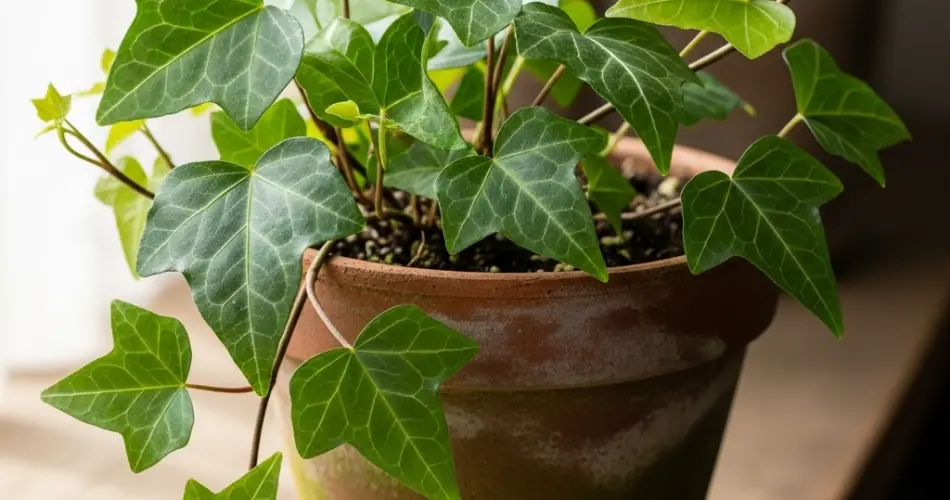English ivy (Hedera helix) is a versatile and hardy houseplant, valued for its trailing vines, lush green leaves, and ability to enhance indoor spaces. Whether draped from a hanging basket, climbing a trellis, or cascading from a shelf, English ivy adds charm and elegance to any environment. While this plant is relatively low-maintenance, achieving healthy, vigorous growth relies heavily on proper soil moisture management.
Maintaining the right balance of moisture is critical. Too little water can cause leaf browning and leaf drop, while too much can lead to root rot and stunted growth. This guide explores practical techniques for keeping English ivy’s soil consistently optimal, ensuring strong vines and vibrant foliage.
Understanding English Ivy’s Water Needs
English ivy thrives in evenly moist soil. Unlike succulents or cacti, it cannot store large amounts of water in its leaves, so it requires regular but careful watering.
-
Moist, not soggy: Soil should feel slightly damp to the touch but should never remain waterlogged. Constantly wet soil deprives roots of oxygen, leading to rot.
-
Even moisture: Avoid letting the soil dry out completely, as this stresses the plant and can cause yellowing or dropping leaves.
-
Signs of stress: Wilting, browning leaf edges, or slow growth often indicate inconsistent moisture levels.
Understanding these needs is the foundation for maintaining healthy soil conditions.
Choosing the Right Pot and Soil
Proper containers and soil composition are key to managing moisture effectively.
-
Well-draining pots: Always use pots with drainage holes. Excess water should be able to escape freely to prevent root rot.
-
Pot material: Plastic or ceramic pots are both suitable. Plastic retains moisture longer, while ceramic or terracotta pots allow excess water to evaporate more quickly. Consider your watering schedule when choosing the pot.
-
Soil mix: A high-quality, well-draining potting mix works best. Adding perlite, sand, or small bark chips improves aeration and prevents soil compaction. Avoid heavy garden soil, which can retain too much water and suffocate roots.
Selecting the right container and soil ensures water is retained without overwhelming the roots.
Watering Techniques for Optimal Moisture
Consistent watering is critical to maintain healthy soil moisture for English ivy.
-
Check soil before watering: Stick your finger about an inch into the soil. If it feels dry at that depth, it’s time to water.
-
Even watering: Apply water evenly across the surface to encourage uniform root growth. Water until it drains from the bottom of the pot, then empty any excess from the saucer.
-
Bottom watering option: Fill a tray with water and set the pot inside for 15–20 minutes, allowing the roots to absorb water from below. Remove promptly to avoid oversaturation.
-
Avoid overwatering: Repeatedly watering while soil is still wet can cause root rot. Consistency and careful observation are key.
Environmental Considerations
Temperature, humidity, and airflow affect how quickly the soil dries and, consequently, how often you should water.
-
Indoor temperature: English ivy prefers moderate indoor temperatures between 50–70°F (10–21°C). Warmer conditions can cause soil to dry more quickly.
-
Humidity: Ivy thrives in moderate humidity. Dry air accelerates evaporation, requiring more frequent watering. Consider using a humidity tray or grouping plants together to increase local humidity.
-
Air circulation: Good airflow prevents fungal issues and ensures even drying of the soil surface. Avoid placing ivy near drafts or heating vents, which can dry out soil unevenly.
Mulching and Soil Maintenance
Mulching can help maintain consistent soil moisture while reducing evaporation.
-
Organic mulch: A thin layer of fine bark, coconut coir, or sphagnum moss on the soil surface helps retain moisture.
-
Refresh mulch periodically: Replace or fluff the mulch every few months to prevent mold or fungal buildup.
-
Soil aeration: Gently loosen the top layer of soil occasionally to prevent compaction, improving water penetration and root health.
Seasonal Adjustments
Watering requirements may vary with the seasons.
-
Growing season (spring and summer): Soil tends to dry faster, so watering may need to be more frequent. Monitor moisture closely to support vigorous vine growth.
-
Dormant season (fall and winter): Ivy grows more slowly and requires less water. Reduce watering frequency while still preventing the soil from drying completely.
Final Thoughts
Maintaining the right soil moisture is essential for healthy, thriving English ivy. By using well-draining soil, selecting appropriate pots, and implementing consistent watering practices, you can keep your ivy lush, vibrant, and free of stress-related problems. Consider environmental factors like humidity, temperature, and airflow, and make seasonal adjustments to your watering routine.
With careful attention to these techniques, your English ivy will reward you with cascading, glossy vines and vigorous growth year-round, bringing natural beauty and elegance to your indoor spaces.



